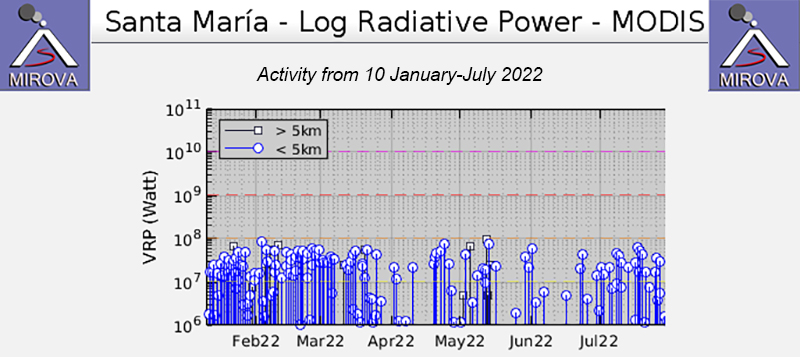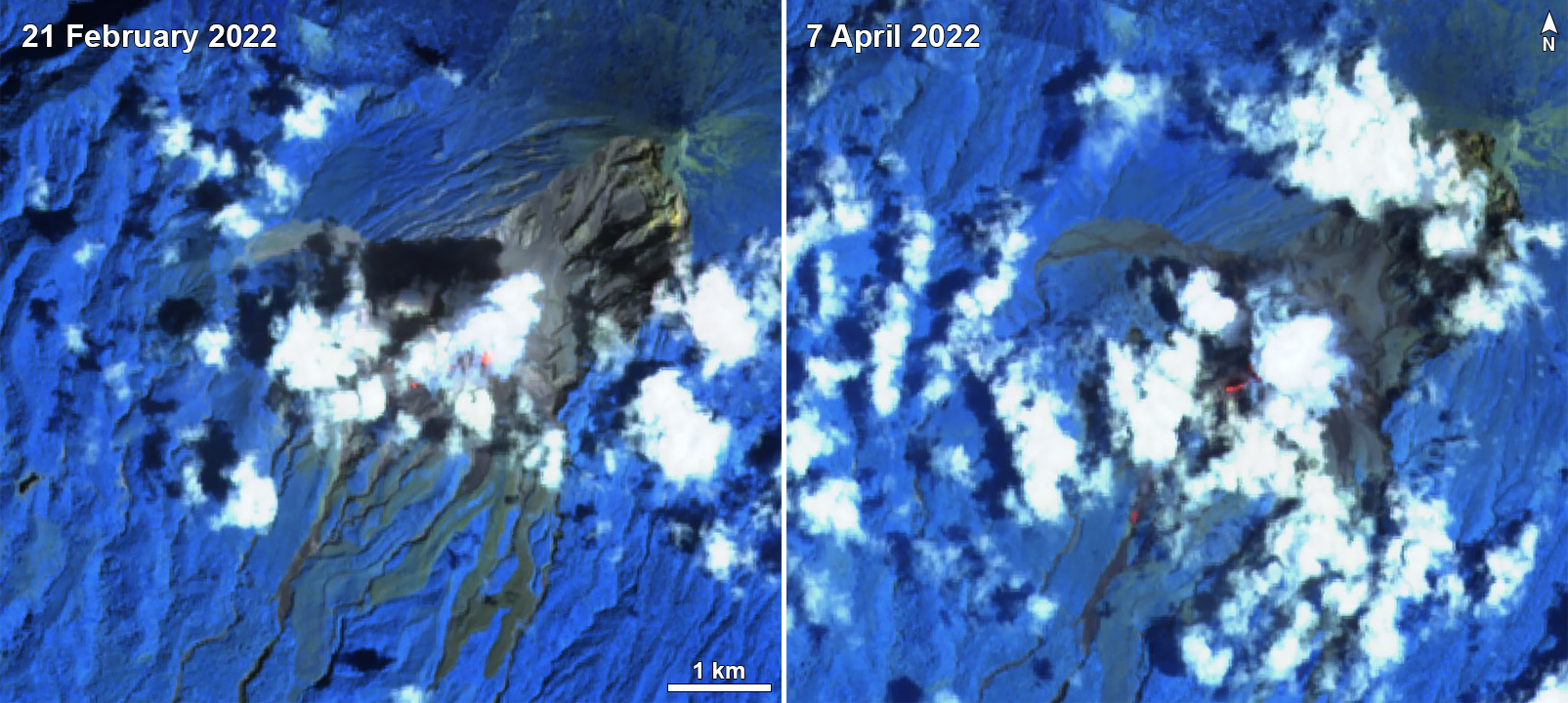Report on Santa Maria (Guatemala) — August 2022
Bulletin of the Global Volcanism Network, vol. 47, no. 8 (August 2022)
Managing Editor: Edward Venzke.
Edited by Kadie L. Bennis.
Santa Maria (Guatemala) Ash plumes, block avalanches, and lava flows persist during February-July 2022
Please cite this report as:
Global Volcanism Program, 2022. Report on Santa Maria (Guatemala) (Bennis, K.L., and Venzke, E., eds.). Bulletin of the Global Volcanism Network, 47:8. Smithsonian Institution.
Santa Maria
Guatemala
14.757°N, 91.552°W; summit elev. 3745 m
All times are local (unless otherwise noted)
The Santiaguito lava-dome complex of Guatemala's Santa María volcano has been actively erupting since 1922. It formed within a large crater on the SW flank which was created during the 1902 eruption. Ash explosions, pyroclastic flows, and lava flows have emerged from Caliente, the youngest of the four vents in the complex, for more than 40 years. The Caliente vent has an elevation of about 2.5 km, and the summit of Santa Maria is at about 3.7 km elevation. A lava dome that appeared within the summit crater of Caliente in October 2016 has continued to grow, producing frequent block avalanches down the flanks. Recent activity, including frequent explosions, ash plumes, and block avalanches (BGVN 47:04), continued during February through July 2022, described here using information from Guatemala's INSIVUMEH (Instituto Nacional de Sismologia, Vulcanologia, Meterologia e Hidrologia) and satellite data.
Activity during February consisted of white-to-gray gas-and-steam emissions that rose to 200-800 m above the dome and drifted N, W, and SW. Moderate avalanches were reported down the SW, W, S, and NE flanks. Many of these avalanches reached the base of the lava dome and caused ashfall to the W and SW of the volcano, which primarily affected Loma Linda (6 km WSW) and San Marcos Palajunoj (8 km SW). The Caliente lava dome continued to grow and show nighttime and early morning crater incandescence as lava effusions occurred to the WSW. Resulting block-and-ash avalanches occurred frequently throughout the month. On 2 February ashfall was reported in Loma Linda Palajunoj and San Marcos Palajunoj. On 3 February pyroclastic flows were recorded at 0303, 0327, and 0633 that descended the SW and W flanks. As a result, fine ash particles were also generated, moving W and SW, some of which was reported in San Martin Sacatepéquez (11 km NW), Llanos del Pinal (6 km NNE), Xecaracoj (7 km NNE), Loma Linda, and El Palmar (12 km SSW), all in the department of Quetzaltenango. A distinct sulfur smell was detected 7 and 8 km SW of the volcano on 3 and 4 February, respectively. During the night and early morning of 4-5 February weak incandescence was visible from the Caliente dome and lava flows were reported on the W flank. Avalanches remobilized ash to 4 km altitude, which drifted as far as 30 km to the SSW. Two lava flows were reported on the W and SW flanks on 6 February, measuring 500 and 700 m long, respectively. Ashfall was reported in San Marcos Palajunoj, San Luis, and San Sebastián. Crater incandescence at the Caliente dome persisted. A lahar descended the San Isidro River, a SSW-flank tributary of the Tambor River, on 8 February. By 11 February the two lava flows on the W and SW flank reached 600 and 800 m long, respectively, and ash that was generated by frequent avalanches was deposited in Loma Linda Palajunoj and San Marcos Palajunoj. On 26 February incandescence was visible as high as 75 m above the dome.
During March, gas-and-steam emissions that rose 100-1,000 m high over the Caliente dome drifted in different directions. Weak to moderate block avalanches affected the SW, W, and S flanks, causing fine ashfall around the perimeter of the volcano. Nighttime and early morning crater incandescence was consistently visible; lava effusions in the WSW direction persisted in the lava dome. Lava flows remained active on the W and SW flanks. The front of the lava flow in the San Isidro river showed signs of collapse on 24 and 29 March, which generated an ash plume 300 m high.
Similar eruptive activity continued during April, with gas-and-steam emissions rising 50-800 m above the crater and drifted dominantly W and SW. Nighttime crater incandescence in the vicinity of the lava dome persisted, as the lava flows on the W and SW flanks remained active. Fine ash deposits were visible on the SW flank on 1 April. A sulfur odor was intermittently during the month. Avalanches of variable strength were recorded in the front of the lava flows on mainly the W and SW flanks, as well as on the SE, S, and N flanks. The avalanches also generate ash plumes that move W, depositing ashfall on San Marcos Palajunoj and Loma Linda Palajunoj during 2-3 April. Residents also reported the smell of sulfur in Las Marias. Collapses from the lava flow front into the San Isidro river on 4, 10, and 16 April generated ash plumes up to 300 m high. By 14 April the lava flow had reached 2,100 m elevation, with material piling up at the front of the flow as well as around the Caliente dome. Ashfall was reported in San Marcos Palajunoj and Loma Linda Palajunoj that same day.
White-to-gray gas-and-steam emissions continued to rise 400-800 m above the crater and drifted in various directions during May. Nighttime and early morning incandescence was observed from the growing Caliente lava dome and the active lava flows on the W and SW flanks. Weak to moderate avalanches were recorded at the front of the flows on the W and SW flanks, as well as down the S flank. Occasional ashfall deposits and the smell of sulfur were reported in communities around the volcano. During 9-15 May suspended ash was reported in multiple locations. On 14 and 20 May incandescence was visible at night 75 m above the Caliente dome; the lava flow remained active on the W and SW flanks. On 22 May collapses at the front of the lava flow, which measured 3 km long, produced an ash plume 300 m high. Ash deposits were reported during 22-23 May near the summit, including in El Faro, La Florida, and San José. By 24 May the lava flow reached 3.3 km long in the San Isidro river and continued to generate ash plumes to the S and SW from avalanches. On 27 May ashfall was detected in San Marcos Palajunoj and Loma Linda Palajunoj. Cement-like lahars descended the Cabello de Ángel drainage (a tributary of Nimá I on the SE flank) during 27-28 May, carrying tree trunks, branches, and blocks up to 1 m in diameter. On 29 May an ash plume was reported to 3 km altitude and weak-to-moderate avalanches and lava flows continued on the WSW and S flank.
Activity continued during June with constant gas plumes rising 200-700 m above the Caliente dome that drifted as far as 5 km E and 8 km SW. Weak avalanches were constantly observed on the W, SW, and S flanks, as well as in the dome. A lava flow continued to descend the SW and W flanks, which resulted in weak avalanches, incandescence, and some ashfall deposits. On 3 and 9 June the active lava flow in the San Isidro river produced avalanches that caused ash to rise 300 m above the crater. Occasionally a weak sulfur odor was noted around the volcano. Fine ashfall was reported in Santa Mara and Viejo Palmar on 4 June. Ashfall was also visible on 7 June in San Marcos Palajunoj, on 11 and 16 June deposits were reported in the upper part of Finca El Faro and San José Patzulin, and on 12 and 27 June deposits were visible in San Marcos Palajunoj and Loma Linda Palajunoj. Weak to moderate avalanches generated 1-km-high ash plumes that drifted SW as far as 5 km.
Activity persisted during July. White gas-and-steam emissions rose 100-700 m above the crater and drifted SW and W; on 22 and 23 July the emissions drifted as far as 6 km SW and W. Incandescence continued to be visible above the Caliente dome. Block avalanches descended the W, SW, S, and SE flanks, generating ash emissions. The active lava flow measured 3 km long on the SW and W flanks on 1 July, and by 7 July it was 3.5 km long. On 6 July an ash plume rose 1 km above the crater due to the constant avalanches down the W, SW, and S flanks. Ashfall was reported in San Marcos Palajunoj and Loma Linda Palajunoj on 9 July. By 15 July the active lava flows measured 3.8 km long, moving down the San Isidro and Tambor drainages. On 23 and 28 July the avalanches generated ash emissions that rose 800 m above the crater that extended 3 km E. Some lava flow deposits were observed in the Seco river. Ashfall deposits were reported in La Florida and Santa Marta farms on 25 July. INSIVUMEH reported that on 31 July the block avalanches generated moderate pyroclastic flows that burned parts of nearby vegetation.
Persistent thermal activity was recorded during February through July 2022, as reported by MIROVA (figure 132). The rate of the anomalies was higher during January through March, though the levels at which they occurred were relatively consistent. There was a brief gap in activity during late March through late April, where few low- to moderate-power anomalies were detected. During late April the anomalies continued at a slightly higher rate. The MODVOLC thermal algorithm detected a total of 59 hotspots on 3, 5, 9, 12, 14, 15, 16, 18, 20, 21, 23, 26, and 28 February, 2, 4, 6, 7, 13, 14, 15, 16, 19, and 25 March, 2, 17, 19, and 24 April, 3 May, 23 June, and 1, 5, 13, 18, and 25 July. On clear weather days, Sentinel-2 infrared satellite imagery showed a small thermal anomaly over the Caliente vent on 21 February and 7 April 2022 (figure 133).
Geological Summary. Symmetrical, forest-covered Santa María volcano is part of a chain of large stratovolcanoes that rise above the Pacific coastal plain of Guatemala. The sharp-topped, conical profile is cut on the SW flank by a 1.5-km-wide crater. The oval-shaped crater extends from just below the summit to the lower flank, and was formed during a catastrophic eruption in 1902. The renowned Plinian eruption of 1902 that devastated much of SW Guatemala followed a long repose period after construction of the large basaltic andesite stratovolcano. The massive dacitic Santiaguito lava-dome complex has been growing at the base of the 1902 crater since 1922. Compound dome growth at Santiaguito has occurred episodically from four vents, with activity progressing E towards the most recent, Caliente. Dome growth has been accompanied by almost continuous minor explosions, with periodic lava extrusion, larger explosions, pyroclastic flows, and lahars.
Information Contacts: Instituto Nacional de Sismologia, Vulcanologia, Meteorologia e Hydrologia (INSIVUMEH), Unit of Volcanology, Geologic Department of Investigation and Services, 7a Av. 14-57, Zona 13, Guatemala City, Guatemala (URL: http://www.insivumeh.gob.gt/); MIROVA (Middle InfraRed Observation of Volcanic Activity), a collaborative project between the Universities of Turin and Florence (Italy) supported by the Centre for Volcanic Risk of the Italian Civil Protection Department (URL: http://www.mirovaweb.it/); Hawai'i Institute of Geophysics and Planetology (HIGP) - MODVOLC Thermal Alerts System, School of Ocean and Earth Science and Technology (SOEST), Univ. of Hawai'i, 2525 Correa Road, Honolulu, HI 96822, USA (URL: http://modis.higp.hawaii.edu/); Sentinel Hub Playground (URL: https://www.sentinel-hub.com/explore/sentinel-playground).



